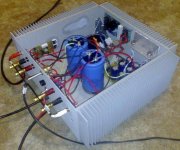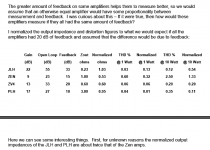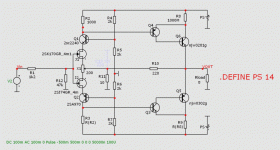Le monstre Regulated pics
Hi all here is a pic of my regulated le monstre,
and the link.
http://diyaudioprojects.com/Solid/Jean-Hiraga-Le-Monstre/
-Dan
Hi all here is a pic of my regulated le monstre,
and the link.
http://diyaudioprojects.com/Solid/Jean-Hiraga-Le-Monstre/
-Dan
Attachments
Hi Dan!
Yes, me too, but with unregulated giga PSU like the original. Not bad. It is good for a reference PP amp.
Greets:
Tyimo
I have to say the amplifier sounds really really good has any one else tried it ???
Yes, me too, but with unregulated giga PSU like the original. Not bad. It is good for a reference PP amp.
Greets:
Tyimo
HKC said:What idss class (GR/BL/V) of the 2SK170/2SJ74 should be used
for the Hiraga "le monstre" power amp
to get the best sounding result?
hey.
This nobody knows. you just would have to try and listen.
As you ask about 'sound'.
If you mean technically best data of operation into a specific LOAD
it may be easier to try to test or simulate an optimal bias of input stage.
The short answer is, the input FETs should be biased
to get the desired Class A idle current in Output stage.
This current level, would be your choice.
would be different for different wanted power output into different LOADs.
4, 6 or 8 Ohms speakers
This version of Hiraga, in image, uses 2SK246 / 2SJ103
and the bias is set to like 4 mA, for ~ 1 Ampere in output stage.
But I am sure you use some other version / setup
for the Hiraga monster.
An externally hosted image should be here but it was not working when we last tested it.
HKC said:
Hi Lineup
Thank you for your answer.
Yes I meant technical best data. My speaker load is 8 Ohm and I will use parts as specified on original schematic which the input JFets are 2SK170 & 2SJ74
Best Regards
danieljw said:Hi All,
Lineup = interesting answer
HKC = see the link in my signature line or google the "class a amplifier site" it has the info in the jean hiraga index.
-Dan
I forgot.
I think you should buy/use 2SK170BL + 2SJ74BL
They should be like max 8-10 mA, I think.
They are also the easiest variant to find. Nelson Pass uses often 2SK170BL
( GR variant is only like half as much current. And this may be too little )
Refereing to image in my post.
Depending on different JFET, you may even have to use 220 or 470 Ohm potentiometer.
The procedure for seeting like 1 A current in output, can take some time.
For 8 Ohm speakers, this would be my initial current setting.
When you have 1 Volt DC across both 1 Ohm resistors, you will have 1 Ampere running.
What factors effects (most) how much current/voltage across 1 Ohm resistors?
Several things:
1. What JFETs.
And different exemplars of same 2SK170 can differ.
2. THe potentiometer.
220 Ohm = more current.
470 Ohm pot less current.
3. Value of '390 Ohm's resistors.
Higher value = more ampere in output.
Lower value less current.
====================================
Visit Dan's homepage, like he said. Inpprvious post.
I am also sure he can guide you well
how you should do, to trim and adjust Le Monstre
in a safe and good way.
... because if you are unlucky ... you may do a BurnOut
.. at first Power on
Lumba Ogir said:lineup,
can you estimate the open-loop gain and feedback level of your version?
I have not built Le Monstre.
I have only looked at schematic and read a bit.
but,
some day soon, I thought I should setup this nice Class A amplifier
in my MultiSim spice. (torrent download pirate cracked pro version)
And then I may tell about open loop and feedback level
and THD, AC bandwidth and show the harmonics Fourier spectrum.
How much 2nd, 3rd .. 7th dist ...
I guess this is a rather ear-friendly distortion (Class A + JFETs).
Right now I am a bit busy.
To do a spice and fair simulation of this classical amp is easy, very easy.
Because use very common transistors/jfet.
Such that there are very good virtual spice models for.
And is not very complex.
Mr. Hiraga really knew about Keep-It-Simple-And-Good
regars
Lumba Ogir said:lineup,
can you estimate the open-loop gain and feedback level of your version?
Lumba Ogir said:thank you lineup, I am waiting...
Lumba.
You should really have a read on a Nelson Pass paper from 2005.
.. unless you have already studied this great paper
See his investigation on feedback factor, in 4 rather classical amplifiers.
JLH is one of them.
I have attached a little teaser image.
Go download at www.passdiy.com
The PLH Amplifier: The classic JLH - Pass style
Then you thank me, lineup, for telling.
But most of all give a nice thought to Our One and Only Nelson.
For doing a good audio work .. and sharing it with us
Attachments
danieljw said:Hi All,
Lineup = interesting answer
HKC = see the link in my signature line or google the "class a amplifier site" it has the info in the jean hiraga index.
-Dan
Hi Daniel
Your Le Monstre link is very interesting.
According to the power supply schematic. You use 2 LM338K for both of the upper and lower section. As far as I know, LM338K is a positive regulator therefore, should there be 1 LM338K and another negative regulator to form the regulator section instead of 2 LM338K? In addition, the two voltage rails are specified as -12V. Is this typing error? I think they should be +12V & -12V respectively. Correct me if I am mistaken.
Back to the Le Monstre schematic. Is the 100 Ohm trim pot use to adjust the voltage at output? Please advice.
Thanks & regards
lineup said:
I forgot.
I think you should buy/use 2SK170BL + 2SJ74BL
They should be like max 8-10 mA, I think.
They are also the easiest variant to find. Nelson Pass uses often 2SK170BL
( GR variant is only like half as much current. And this may be too little )
Refereing to image in my post.
Depending on different JFET, you may even have to use 220 or 470 Ohm potentiometer.
The procedure for seeting like 1 A current in output, can take some time.
For 8 Ohm speakers, this would be my initial current setting.
When you have 1 Volt DC across both 1 Ohm resistors, you will have 1 Ampere running.
What factors effects (most) how much current/voltage across 1 Ohm resistors?
Several things:
1. What JFETs.
And different exemplars of same 2SK170 can differ.
2. THe potentiometer.
220 Ohm = more current.
470 Ohm pot less current.
3. Value of '390 Ohm's resistors.
Higher value = more ampere in output.
Lower value less current.
====================================
Visit Dan's homepage, like he said. Inpprvious post.
I am also sure he can guide you well
how you should do, to trim and adjust Le Monstre
in a safe and good way.
... because if you are unlucky ... you may do a BurnOut
.. at first Power on

Hi Lineup
Thank you for your detailed reply.
I have some 2SK170bl/2SJ74BL available to use for this power amp. I have to measure to see what is the idss of these JFets.
What is the bias current at the output stage of the original design of the Le Monstre? I would like to set the bias current same as the original design.
Thanks again.
Using MicroCap, I simulated the le Monstre, see schematic attached, and CL gain is 24 dB and OL gain is only 37 dB.
THD is about 0,07% at 1kHz and 8Vpeak output.
It is quite amazing that OL gain is flat up to 1MHz!
I have used the GR grades of SK170/SJ74 with Idss = 4mA,
and the pot is 200 Ohm, as to get about the same drain
currents in the JFETs as in the original design.
Lumba,
if you download the free eval version of MC, you can simulate the le Monstre - it is easy as pie.
You can get my MC file if you wish.
Sigurd
THD is about 0,07% at 1kHz and 8Vpeak output.
It is quite amazing that OL gain is flat up to 1MHz!
I have used the GR grades of SK170/SJ74 with Idss = 4mA,
and the pot is 200 Ohm, as to get about the same drain
currents in the JFETs as in the original design.
Lumba,
if you download the free eval version of MC, you can simulate the le Monstre - it is easy as pie.
You can get my MC file if you wish.
Sigurd
Lumba Ogir said:lineup,
can you estimate the open-loop gain and feedback level of your version?
Lumba Ogir said:lineup,
well, Hiraga`s design is simply genial, I`ve never seen anything so eccentric neither before nor after.
You are about to raise the open-loop gain, I would go in the other direction...
Attachments
500m - 600mV over 1 Ohm is the Ib value,
which is too little, IMO, to get 8W into
8 Ohms. Into 4 Ohms you will only have half of what you get at ( Ohms (into class A).
I have played with the Hiraga le Monstre and am running at
2.5A idle current and that at about 20V rails using 0302/0281 Onsemi transistor. Needs some heavy duty fan cooling
which is too little, IMO, to get 8W into
8 Ohms. Into 4 Ohms you will only have half of what you get at ( Ohms (into class A).
I have played with the Hiraga le Monstre and am running at
2.5A idle current and that at about 20V rails using 0302/0281 Onsemi transistor. Needs some heavy duty fan cooling
HKC said:
What is the bias current at the output stage of the original design of the Le Monstre? I would like to set the bias current same as the original design.
Thanks again.
- Home
- Amplifiers
- Solid State
- Hiraga "Le Monstre"


